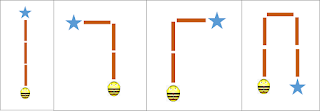Bee-Bot - Day 3 (Younger Group)
2. Objectives
● To understand how to make Bee-Bot move.
● To try to make the sequence of commands.
3. Key Concepts
● Direction / Sequence of Commands / Programming
4. Georgia Standards
Pre-K
|
|
LD3b
|
Uses new
vocabulary words correctly within the context of play or other classroom
experiences.
|
MD1f
|
Begins to identify ordinal numbers.
|
MD1g
|
Associates numeral name with set of
objects.
|
MD2a
|
Copies a pattern using sounds or physical
movements.
|
MD4c
|
Uses language to indicate where things are
in space: positions, directions, distances, order.
|
SD3b
|
Investigates different types/speeds of
motion.
|
CD2a
|
Uses music and movement to express
thoughts, feelings, and energy.
|
CD2b
|
Explore various music types, musical
instruments, and music from various cultures.
|
SE2d
|
Develops independence during activities,
routines, play.
|
SE3d
|
Manages transitions and adapts to changes
in routine.
|
HPD1b
|
Coordinates movements to perform tasks.
|
K
|
|
ELACCKL6
|
Use words and phrases acquired through conversations,
reading and being read to, and responding to texts.
|
MCCKCC3
|
Write numbers from 0 to 20. Represent a
number of objects with a written numeral 0 – 20.
|
MCCKCC4
|
Understand the relationship between
numbers and quantities; connect counting to cardinality.
|
MKG3b
|
Extend a given pattern and recognize
similarities in different patterns.
|
MCCKG1
|
Describe objects in the environment using
names of shapes, and describes the relative positions of these objects using
terms such as above, below, beside, in front of, behind, and next to.
|
SKCS4b
|
Describes changes in size, weight, color,
or movements, and note which of their other qualities remains the same.
|
SKP2
|
Students will investigate different types
of motion.
|
SSKG2
|
Students will explain that a map is a
drawing of a place and a globe is a model of the earth.
|
PEK1a
|
Demonstrates basic movement in general and
personal space.
|
PEK4. 1a
|
Participates in fitness and conditioning activities.
|
PEK5.1
|
Exhibits responsible personal and social behavior
that respects self and others in physical activity setting.
|
5. Procedures
1) Get an individual Bee-Bot.
2) Review each button on the Bee-Bot and the procedure to give commands.
- You have to move your Bee-Bot only by pushing buttons, not using your hands.
3) Look though different ‘line routes’ and choose a line route.
(Children can have different levels of line routes depending on children’s ages and understanding.)
4) Think about what commands Bee-Bots need to move along with the lines.

5) Have free time to make individual Bee-Bots move along with the lines.
- What
commands do your Bee-Bot need to go to this star?
- In this place, which direction does your
Bee-Bot has to turn, right or left?Level 1
Level 2

6) Show how my Bee-Bots move along with the lines to others.
- Who wants to show us how your Bee-Bot moves?
- What commands did you use?
6. Review of Today’s Activity.
- When Bee-Bots have to turn, let’s think which direction the Bee-Bots have to turn.
- If you give commands all together, you can make your Bee-Bot move at once without stop.



